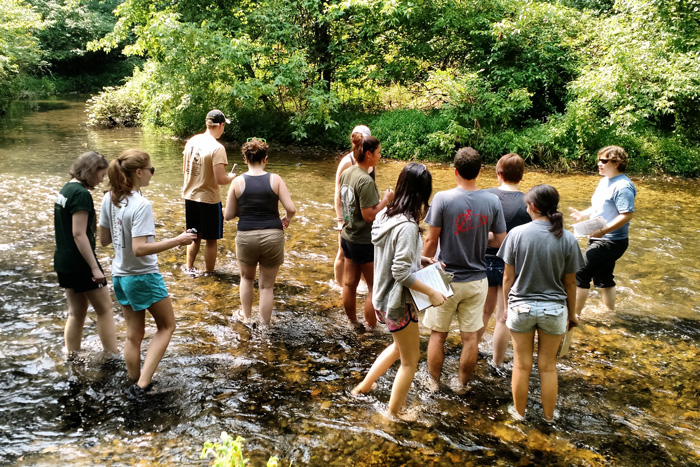ALLARM Grants Support Student Work in Conservation, Citizen Science

$816K to be applied over six-year span
by MaryAlice Bitts-Jackson
Students involved with Dickinson’s Alliance for Aquatic Resource Monitoring (ALLARM) will be making waves with help from major grants supporting long-term conservation and citizen-science initiatives. The funding includes support for two ALLARM projects that connect students to on-the-ground environmental policy implementation focusing on the Chesapeake Bay.
ALLARM has launched a partnership with the National Fish and Wildlife Foundation Chesapeake Bay Stewardship Fund to assess progress on 2026 nutrient and sediment goals for the Chesapeake Bay. Along with its Chesapeake Monitoring Council (CMC) partners, the Dickinson group will collaborate with regional stakeholders to develop a community-based restoration monitoring protocol.
The team has 18 months to research the protocol, study design development, and develop and test the protocol, which is the first of its kind in the U.S., according to ALLARM Director Julie Vastine. Last year, six Dickinson students laid a foundation when they conducted background research on stream restoration and data collection techniques and presented their findings to the CMC team.
Phoebe Galione '21 (environmental science, earth sciences) created an illustrated guide to help volunteers implement visual monitoring techniques; Olivia Spildooren ’21 (environmental science) researched the benefits of long-term riparian projects and pulled together studies that evaluated stream restoration projects; Shante Toledo ’21 (environmental studies, Italian studies) investigated invasive plants that grow where forest buffer plants take place; Isabel Ruff ’21 (environmental science) researched bird species and water quality; Hiba Aoid ’21 (earth sciences, environmental science) identified options for using photography to monitor long-term conservation efforts; and Angelo Tarzona ’21 (earth sciences) researched tools used to evaluate stream substrate material and sediment runoff.
As the New York and Pennsylvania CMC partner, ALLARM also was awarded $455,000 through the CMC cooperative, which received renewed funding from the Environmental Protection Agency-Chesapeake Bay Program to continue its work through 2026. ALLARM students and staff will continue to train citizen-science volunteers and community partners on how to collect water quality data on streams and tributaries. The team will integrate water-quality data into a regional Chesapeake Data Explorer database.
ALLARM additionally was recently granted a 2.5-year, $145,000 award as a founding member of the 20-year-old Consortium for Scientific Assistance to Watersheds from the Pennsylvania Department of Environmental Protection. This funding will provide quality control support to citizen-scientists to verify that they are using their equipment correctly and to provide technical support to Pennsylvania partner. And for the third consecutive year, ALLARM students and staff are engaging volunteers with the Susquehanna Stream Team 2021, with help from the Campbell Foundation’s $35,000 grant.
Each of these projects and initiatives bring students meaningful opportunities in citizen-science, policy and advocacy, Vastine says.
“We are beyond thrilled that, even with navigating COVID restrictions, we have been able to grow our Stream Team program and find cool ways to engage our volunteers,” she says, noting that Stream Team has grown to include 125 volunteers in seven Pennsylvania counties. “And ALLARM students were pivotal in the program’s innovative work, from planning learning games to teaching volunteers to interpret their data.”
TAKE THE NEXT STEPS
Published August 10, 2021